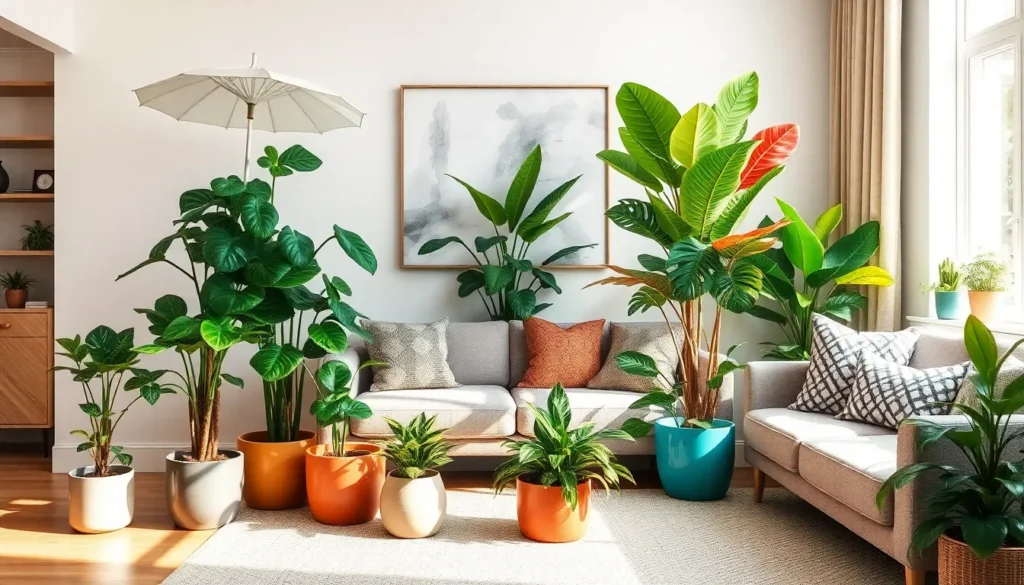We’ve all walked into a living room and instantly felt that something was missing. The furniture looks perfect the lighting’s just right but the space feels flat and lifeless. That’s where the magic of living room plants comes in to completely transform your space from ordinary to extraordinary.
Plants aren’t just pretty decorations – they’re powerful design elements that breathe life into any room. They purify your air create natural focal points and add those gorgeous pops of green that make everything feel more vibrant and welcoming. Whether you’re working with a tiny apartment or a sprawling family room the right plants can make your living space feel like a designer showcase.
We’re about to show you exactly how to choose style and arrange plants that’ll turn your living room into the Instagram-worthy oasis you’ve always dreamed of. From low-maintenance options for busy lifestyles to statement plants that steal the show – we’ve got the insider secrets to make your space absolutely stunning.
Choose the Right Plants for Your Living Room’s Lighting Conditions
Selecting plants that match your living room’s natural light levels ensures they’ll thrive and maintain their decorative appeal. We’ve categorized the best options based on three main lighting scenarios to help you make informed choices.
Low-Light Champions for Dim Corners
Snake plants (Sansevieria) excel in dimly lit spaces and require minimal watering, making them perfect for busy homeowners. Their upright, sword-like leaves create striking vertical lines that complement modern furniture arrangements.
ZZ plants (Zamioculcas zamiifolia) tolerate neglect exceptionally well and produce glossy, dark green foliage that adds sophistication to shadowy areas. These hardy specimens can survive weeks without water while maintaining their lustrous appearance.
Pothos vines work wonderfully as trailing plants from high shelves or hanging planters in low-light corners. Their heart-shaped leaves cascade beautifully and can grow several feet long, creating natural green curtains.
Chinese evergreens (Aglaonema) offer colorful variegated patterns in shades of pink, red, and silver that brighten darker spaces. We recommend placing them near reading nooks or entertainment centers where their decorative foliage can be appreciated up close.
Bright Light Lovers for Sunny Spots
Fiddle leaf figs make dramatic statement pieces in sun-drenched living rooms with their large, violin-shaped leaves. Position them near south-facing windows where they’ll receive 6-8 hours of bright, indirect sunlight daily.
Rubber trees (Ficus elastica) develop thick, glossy leaves that reflect natural light throughout the room. Their tree-like structure works particularly well in corners with abundant sunshine, where they can grow up to 8 feet tall indoors.
Bird of paradise plants create tropical elegance with their paddle-shaped leaves and occasional orange blooms in very bright conditions. We suggest placing them in rooms with floor-to-ceiling windows or glass doors for optimal growth.
Monstera deliciosa produces Instagram-worthy split leaves that cast interesting shadows on walls when placed in bright, filtered light. Their climbing nature makes them excellent choices for rooms with high ceilings and large windows.
Medium-Light Options for Versatile Placement
Peace lilies adapt to various lighting conditions while producing elegant white blooms that complement any decor style. They signal when they need water by drooping slightly, making plant care straightforward for beginners.
Dracaena varieties offer multiple height and color options for medium-light areas throughout your living room. Their spiky foliage creates textural interest without overwhelming smaller spaces.
Spider plants work well in hanging baskets or on plant stands in moderately lit areas. They produce baby plantlets that dangle like natural ornaments, adding movement and visual interest to static room arrangements.
Philodendrons thrive in medium light conditions and come in both trailing and upright varieties to suit different decorating needs. Their heart-shaped leaves and easy-care nature make them reliable choices for living room plant displays.
Create Visual Interest with Varying Plant Heights and Textures
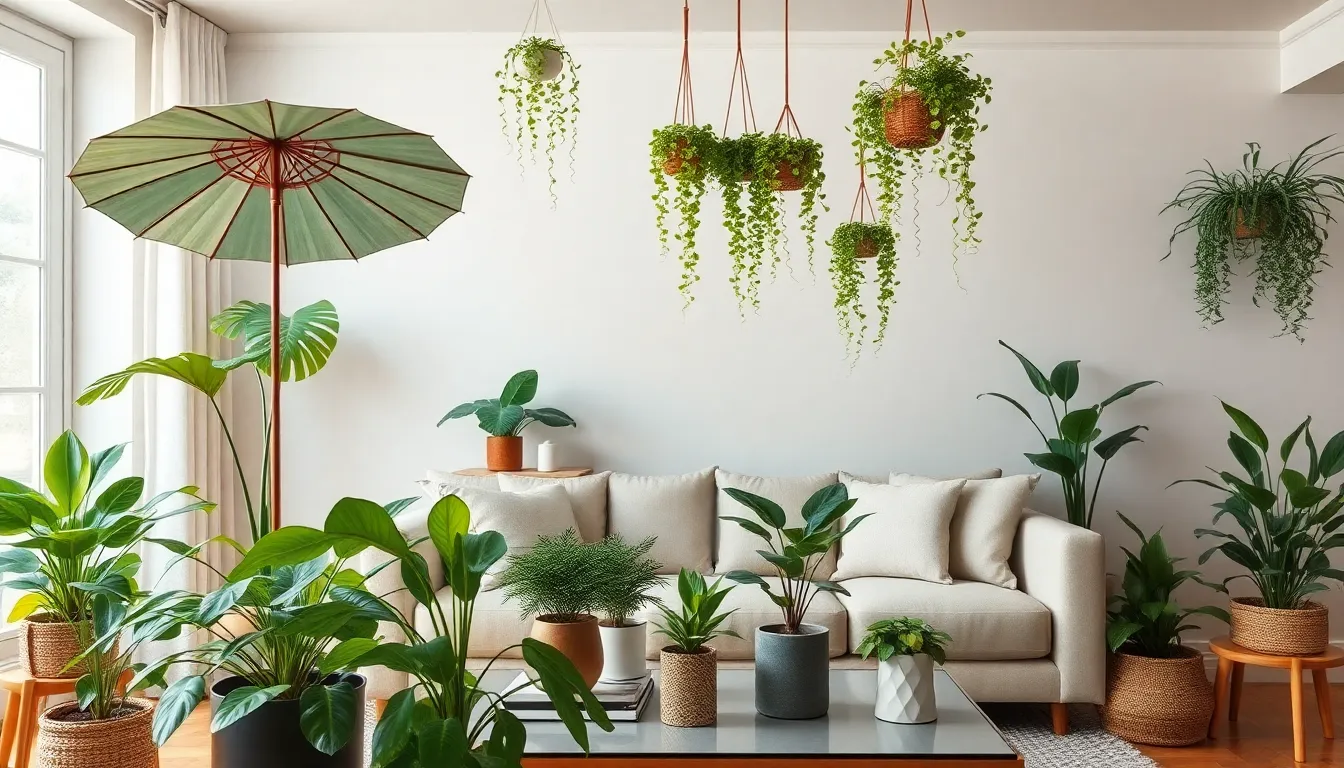
Now that we’ve selected plants based on our living room’s lighting conditions, let’s transform our space into a ever-changing botanical haven. Layering plants of different heights and textures creates depth and visual movement that elevates any living room decor.
Floor Plants as Statement Pieces
Floor plants serve as the foundation of our living room plant design, providing impressive focal points that anchor the entire space. Large specimens like the Umbrella Plant (Schefflera gold capella) or Areca Palm (Dypsis lutescens) create striking visual impact with their imposing size and lush foliage. These tropical beauties thrive in medium, indirect sunlight and require minimal maintenance while adding a jungle vibe to our living areas.
Positioning these statement plants in corners or near seating areas helps define different zones within our living room. Corner placement maximizes floor space while creating natural conversation areas around our furniture. The architectural presence of these plants brings nature indoors and softens hard lines from walls and furniture edges.
Tabletop Plants for Surface Styling
Tabletop plants bridge the gap between our floor specimens and hanging varieties, creating essential middle layer interest. Smaller plants work perfectly on coffee tables, shelves, or side tables without overwhelming our available surface space. We can use stylish containers like vintage crocks, terracotta pots, or glass jars to add personality and charm to these displays.
Grouping plants on tabletops with varied heights and pot designs creates a curated, intentional look that draws the eye across different surfaces. Mix smooth, waxy leaves with feathery or variegated foliage to enhance both tactile and visual appeal. This approach allows us to experiment with different textures while maintaining cohesive styling throughout our living room.
Hanging Plants to Draw the Eye Upward
Hanging plants complete our vertical design strategy by utilizing ceiling space and drawing attention upward throughout the room. Trailing varieties like String of Pearls (Senecio rowleyanus) add elegance with their cascading forms while maximizing vertical space in smaller living rooms. These elevated plants work especially well in homes with pets and children since they’re safely out of reach.
Suspending plants from ceilings or shelf edges introduces gentle movement and helps soften hard architectural lines in our living spaces. The trailing nature of hanging plants creates natural flow between different room levels and adds organic curves to balance straight furniture lines. This vertical element ensures our plant decor feels complete and professionally designed.
Select Stylish Planters That Complement Your Interior Design
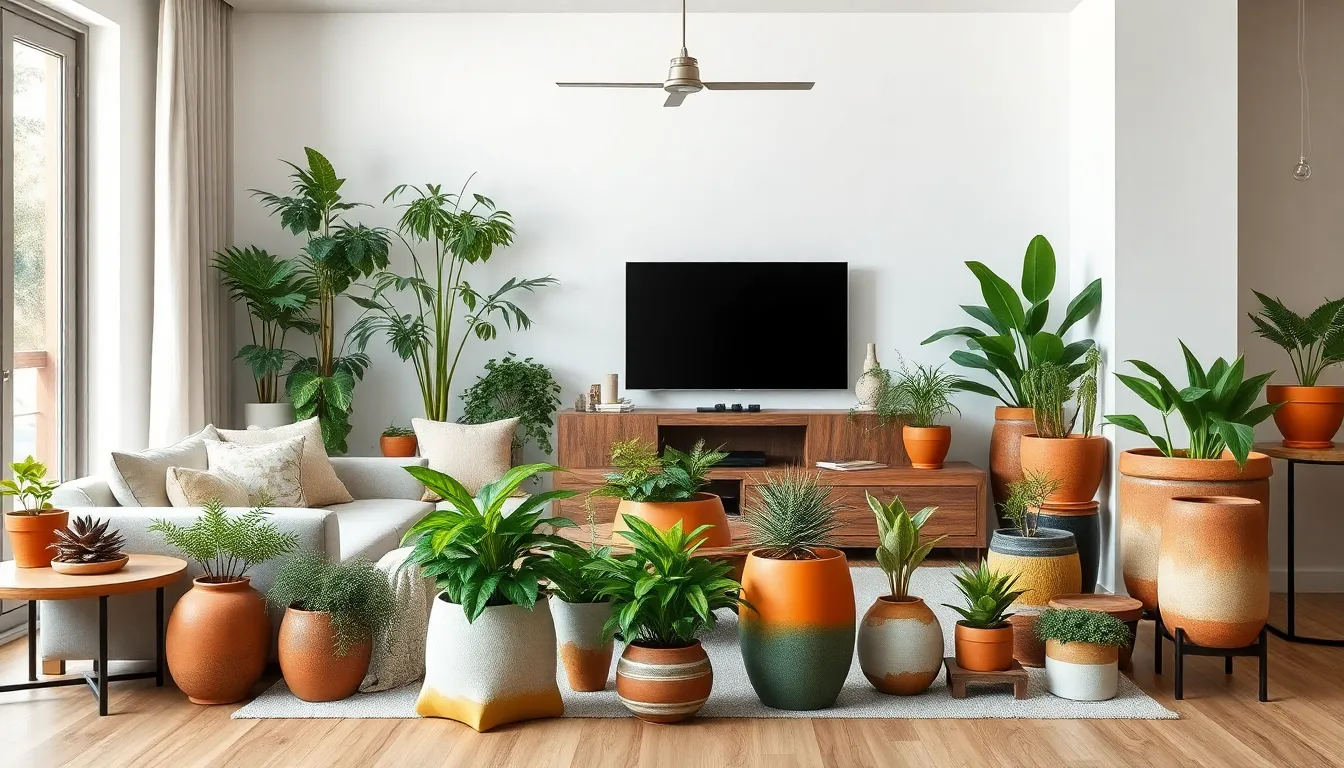
The right planter can transform your living room plants from simple greenery into stunning design elements. We’ll explore three distinct planter styles that enhance different interior aesthetics.
Modern Minimalist Containers
Modern minimalist planters feature clean lines and neutral colors that seamlessly integrate with contemporary living room decor. We recommend choosing containers in white, black, or grey to allow your plants to become the focal point without overwhelming the space. Matte ceramics and smooth metals work exceptionally well for this aesthetic, emphasizing simplicity and elegance in your plant display.
These sleek containers complement modern furniture and architectural elements perfectly. We find that geometric shapes like cylinders and rectangles create visual harmony with contemporary design principles. The understated appearance of minimalist planters ensures your living room plants enhance rather than compete with your existing decor.
Rustic and Natural Materials
Rustic planters bring warmth and texture to cozy, farmhouse, or eclectic living room styles through natural materials. We suggest terracotta pots, vintage crocks, and wooden containers to create an inviting atmosphere that feels both authentic and charming. Thrifted trunks and woven baskets serve as excellent plant bases, adding personality and unique character to your space.
These natural materials develop beautiful patinas over time, improving their rustic appeal. We love incorporating weathered finishes and organic textures that complement boho and eclectic design schemes. The earthy tones of natural planters create a perfect backdrop for both flowering and foliage plants in your living room.
Colorful Statement Pots
Colorful planters act as bold statement pieces that can transform neutral living rooms into vibrant, personality filled spaces. We recommend selecting pots with vibrant hues or artistic patterns that create beautiful contrast with green foliage, turning your plants into striking focal points. These eye catching containers work particularly well in minimalist or neutral living rooms where they add essential pops of color.
Statement pots help unify your overall decor scheme while energizing the entire room. We find that patterned ceramics and brightly colored vessels can tie together accent colors from pillows, artwork, or rugs throughout your living space. The strategic placement of colorful planters creates visual interest points that guide the eye around your room naturally.
Arrange Plants in Odd-Numbered Groupings for Better Visual Appeal
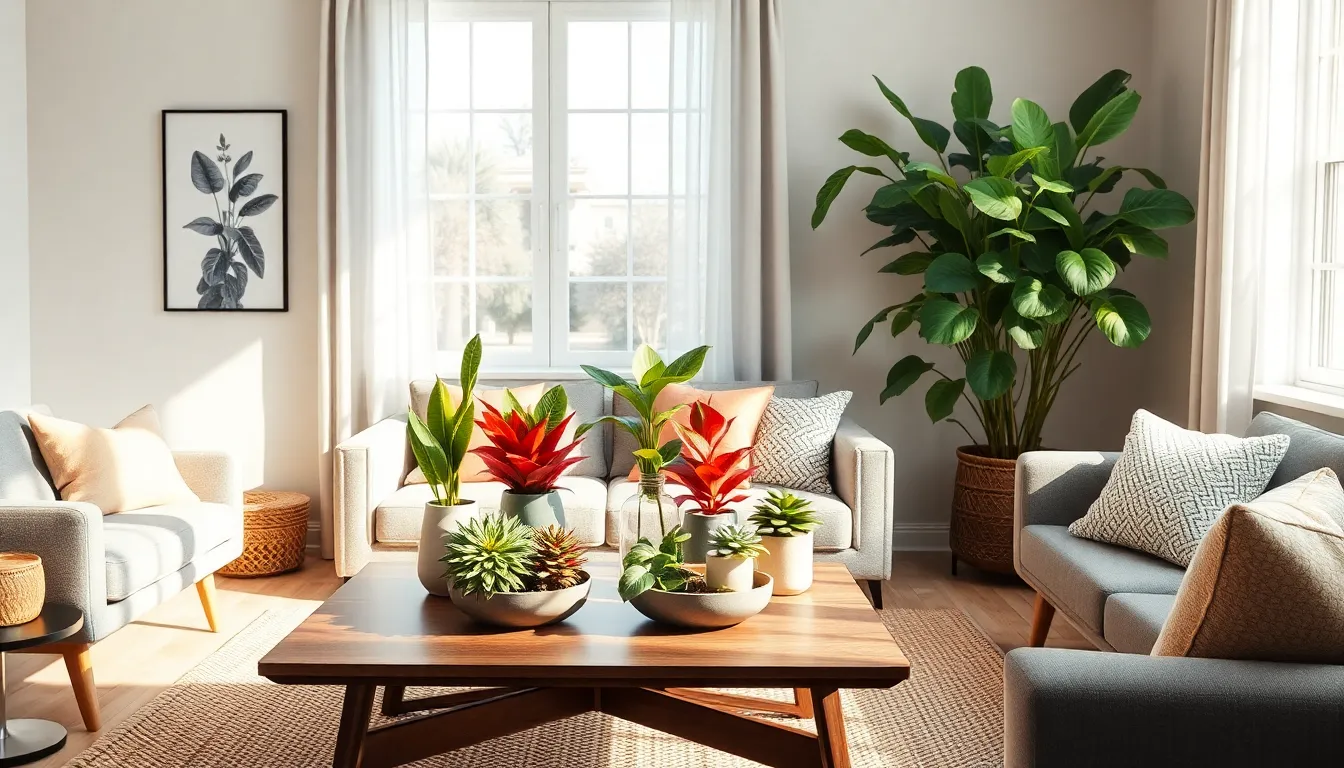
Now that we’ve selected our perfect planters, let’s explore how grouping plants in odd numbers creates a more natural and visually interesting display than even-numbered arrangements.
The Rule of Three for Small Displays
Three plants grouped together offer the perfect starting point for smaller living rooms or minimal plant collections. This classic arrangement works beautifully on shelves, side tables, or windowsills where space is limited. We recommend choosing plants with contrasting heights and foliage textures to amplify the visual effect.
Place three small pots at varying elevations to create instant depth. For example, position a trailing pothos on a plant stand, a compact snake plant at table height, and a peace lily on the floor nearby. This trio grouping provides enough variety to generate visual interest without overwhelming your space.
Consider using pots of similar style or color when creating your three-plant display. Matching containers help unify the grouping while allowing each plant’s unique characteristics to shine through. Terra cotta pots, white ceramic planters, or woven baskets work particularly well for cohesive trio arrangements.
Five-Plant Arrangements for Larger Spaces
Five plants create a lush, layered look that’s perfect for spacious living rooms with generous corners or expansive wall areas. This fuller grouping combines floor plants, mid-height table specimens, and hanging or shelf plants to achieve rich natural vibes throughout the space.
Arrange your five plants at varying heights and distances to fill bigger areas harmoniously. Start with a large floor plant like an Umbrella Plant as your anchor, add two medium-sized plants on plant stands or side tables, include one hanging String of Pearls from the ceiling, and finish with a small accent plant on a bookshelf or mantle.
Mix plants with different leaf colors, shapes, and heights to build texture and depth in your five-plant grouping. Combine broad-leafed specimens like monstera with spiky snake plants, trailing varieties with upright growers, and light green foliage with darker tones. This variety creates visual movement that draws the eye naturally around your living space.
Single Statement Plants as Focal Points
Sometimes one large plant serves as a stunning focal point that commands attention and anchors your entire room design. Plants like the Umbrella Plant, Areca Palm, or fiddle leaf fig work exceptionally well as statement pieces due to their impressive size and striking foliage patterns.
Position your statement plant in a prominent living room corner or near windows where it can grow and naturally draw the eye. These locations provide adequate light for healthy growth while creating a dramatic visual anchor that defines zones within your living space. The plant becomes a living sculpture that enhances your room’s architectural features.
Pair your single statement plant with a stylish planter that enhances its impact and complements your decor style. A sleek modern container works beautifully with minimalist interiors, while a textured ceramic or woven basket planter adds warmth to rustic or bohemian spaces. The right container elevates your statement plant from simple greenery to a true design element.
Incorporate Plants Into Existing Furniture and Shelving
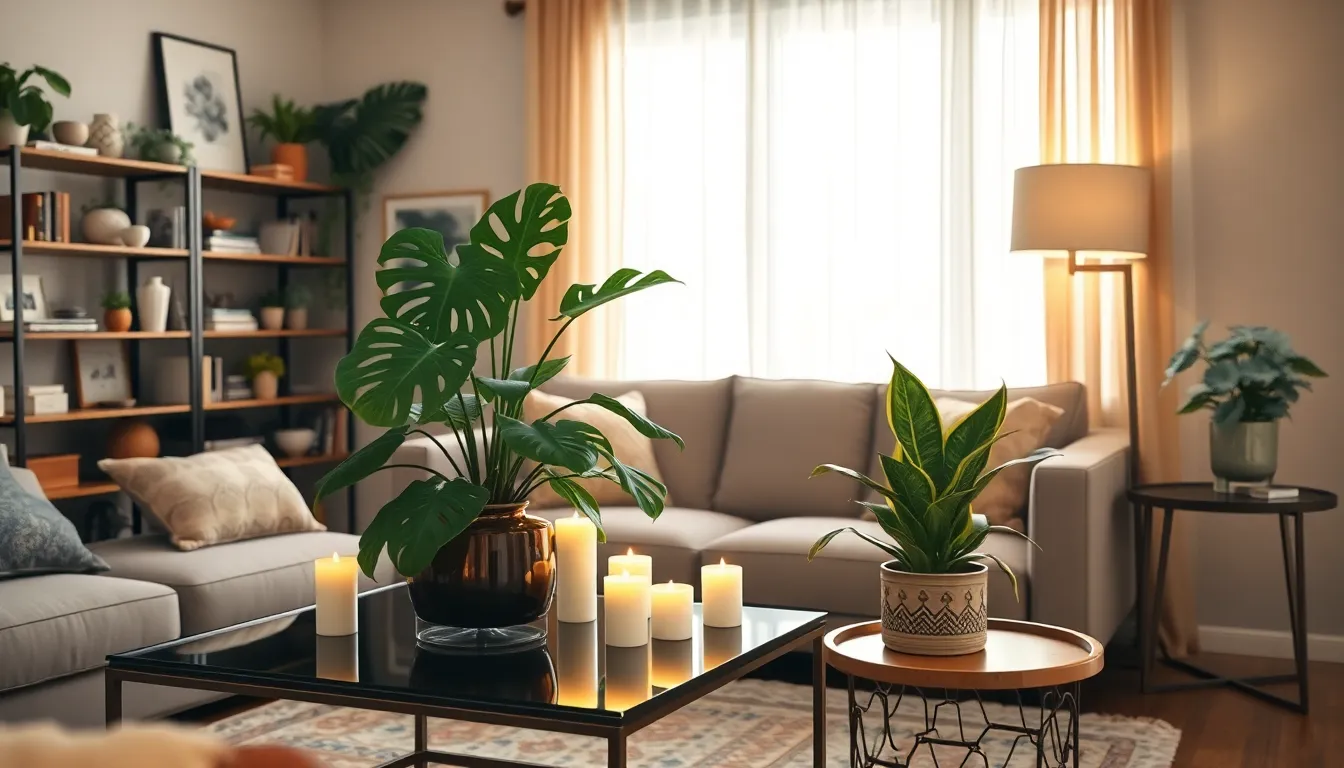
Maximizing your existing furniture creates seamless plant displays that feel intentional rather than added afterthoughts. We’ll transform everyday surfaces into green showcases that complement your living room’s natural flow.
Bookshelf Plant Integration
Trailing plants like String of Pearls (Senecio rowleyanus) work beautifully on high shelves, letting their round leaves cascade elegantly downward for stunning vertical interest. Mix plants with books and decorative items to create balanced displays that feel curated rather than cluttered. Stylish containers make all the difference here – vintage crocks, terracotta pots, and glass jars add personality while housing your green companions.
Choose varying leaf shapes and textures to create visual depth throughout your bookshelf arrangement. Position larger plants on lower shelves where they won’t block access to books, while smaller specimens fit perfectly between volumes on upper tiers.
Coffee Table Centerpieces
Strike a balance with low maintenance plants that command attention without overwhelming your coffee table’s functionality. Monstera Thai Constellation and small palms serve as perfect focal points, adding natural beauty while leaving space for books, candles, and everyday essentials.
Group plants in small clusters or terrariums for that carefully curated aesthetic we all crave. Plants with variegated foliage inject pops of color that brighten neutral coffee table surfaces and tie together your room’s color scheme.
Side Table Accent Plants
Compact powerhouses like pothos, snake plants, and ZZ plants excel on side tables where they fill empty corners with life. These varieties thrive in indirect light conditions and demand minimal care, making them ideal companions for busy lifestyles.
Pair plants with decorative containers to transform ordinary side tables into design features that catch the eye. Using a small vintage trunk or stool as a plant stand creates cozy character while elevating your display to new heights.
Choose drought tolerant options when styling side tables in areas with challenging lighting conditions, ensuring your green accents remain vibrant with minimal intervention.
Use Plants to Define Different Areas Within Your Living Space
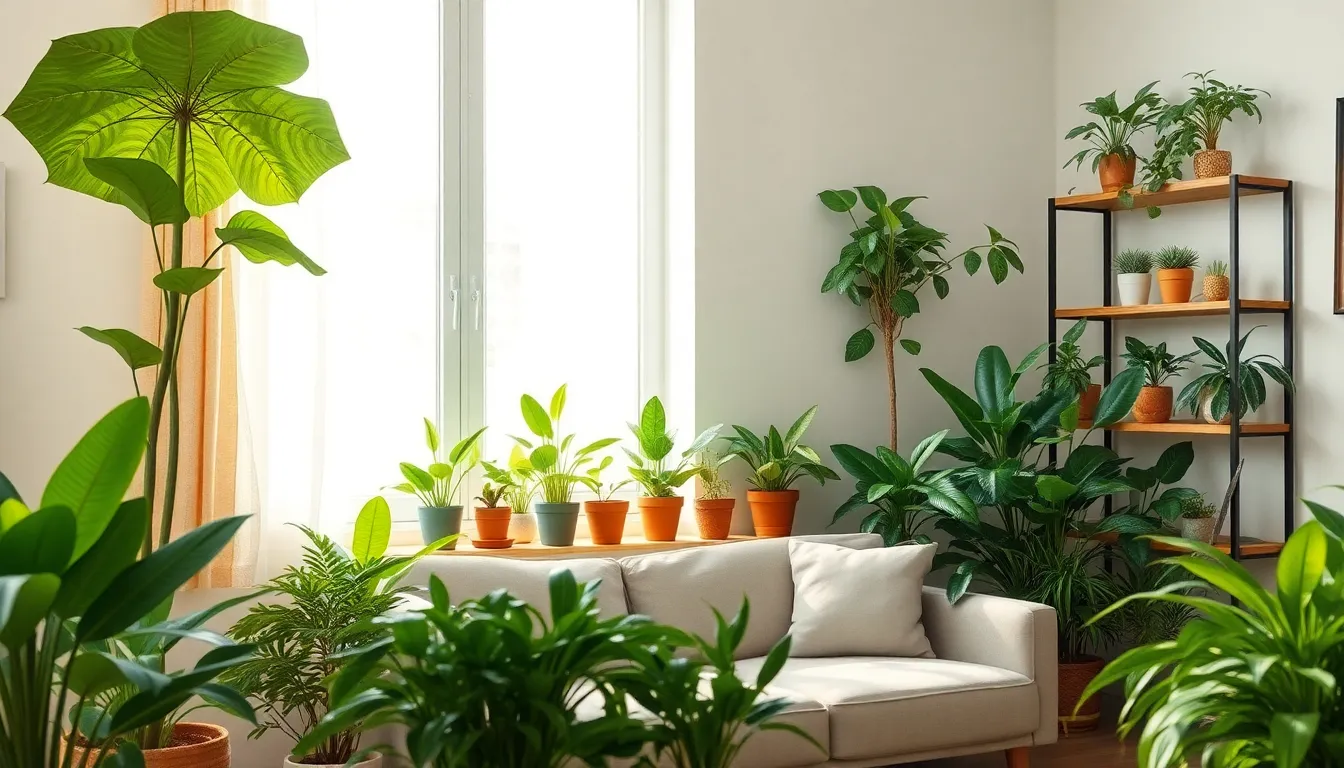
Strategic plant placement transforms your living room into distinct zones without compromising the open feel of your space. We’ll show you how to use greenery as natural markers that subtly separate areas while maintaining visual flow throughout the room.
Creating Natural Room Dividers
Tall plants serve as living partitions that divide spaces while preserving light and airflow. The Umbrella Plant (Schefflera gold capella) reaches impressive heights and creates a lush screen between your living and dining areas. Areca Palm (Dypsis lutescens) offers similar benefits with its full, feathery fronds that provide natural privacy without the bulk of traditional room dividers.
Grouping multiple plants on stands creates a more substantial barrier that feels organic rather than constructed. We recommend arranging three to five plants of varying heights to establish a green wall effect. Plant shelves work particularly well for this purpose, allowing you to create layered displays that naturally separate zones.
Collections of floor plants positioned strategically can define pathways through your living space. Place larger specimens like fiddle leaf figs or rubber trees at transition points to guide movement while maintaining the room’s open concept feel.
Framing Conversation Areas
Plants positioned around seating arrangements create intimate conversation zones that feel naturally enclosed. We suggest placing larger floor plants behind or beside sofas to establish boundaries without blocking sightlines across the room. Combining these anchor plants with smaller tabletop varieties on side tables creates a layered look that draws people into the seating area.
Hanging plants add vertical dimension to conversation spaces while keeping floor areas clear for foot traffic. String of Pearls suspended above or near seating clusters creates visual interest overhead and makes social spaces feel more defined and cozy.
Corner groupings of plants work exceptionally well for framing reading nooks or intimate seating areas. We recommend using three plants of different heights, with the tallest positioned at the back and smaller plants filling in the space toward the front.
Highlighting Architectural Features
Windows become focal points when flanked by plants that complement their scale and proportions. A tall plant like a fiddle leaf fig positioned beside a large window emphasizes the architectural feature while adding life to the space. We suggest choosing plants that won’t outgrow the window opening or block natural light from entering the room.
Built-in shelves gain visual interest when styled with plants of appropriate scale. Small pothos or snake plants on individual shelves create rhythm along the wall, while larger specimens on lower shelves anchor the display. Terracotta pots or vintage containers add character that complements the architectural details.
Fireplace surrounds become more prominent when enhanced with plant displays. We recommend placing plants on the mantel or hearth area to soften hard edges and create a living contrast to stone or brick surfaces. Peace lilies or ZZ plants work well in these locations since they tolerate varying light conditions common around fireplaces.
Mix Live Plants with Complementary Decorative Elements
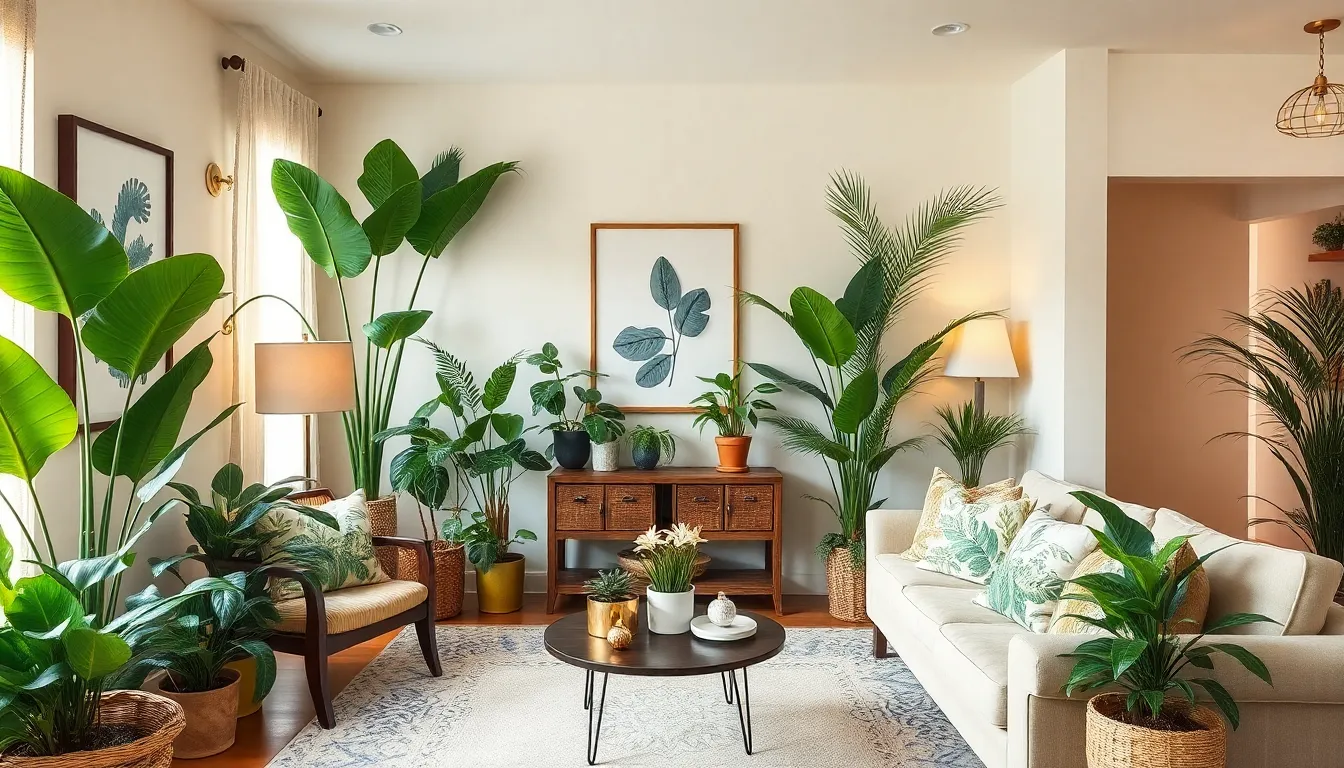
We’ll transform our living room by incorporating decorative elements that enhance our plant displays while creating cohesive design harmony. Building on our strategic placement choices, we can now focus on integrating plants with other decorative features that amplify their natural beauty.
Pairing with Artwork and Wall Decor
Plants create stunning partnerships with wall art when we position trailing varieties like String of Pearls near framed pieces to soften harsh lines and add organic texture. Hanging planters work beautifully alongside paintings and prints, creating living art installations that complement sculptural wall hangings. We can establish visual unity by selecting pot colors that echo the tones in our artwork, while vertical plant displays serve as natural art pieces themselves.
Wall shelves provide perfect opportunities to layer plants with decorative objects, books, and small sculptures. Trailing plants cascading from upper shelves draw the eye upward while framing artwork below. We’ll achieve the most impact by choosing plants that contrast with our wall colors—dark green foliage pops against light walls, while variegated plants add interest to darker backgrounds.
Coordinating with Throw Pillows and Textiles
Throw pillows and textiles create the perfect bridge between our plant displays and furniture, especially when we choose botanical prints and plant-inspired patterns. Leafy green plants pair naturally with pillows featuring tropical motifs, while earthy tones in blankets and rugs echo the natural elements we’ve introduced through our plants.
Textural contrasts enrich our sensory experience when we combine soft fabrics with glossy plant leaves. Cream-colored throws complement the organic shapes of Areca Palms, while brown and green accent pillows reinforce our nature-inspired theme. We can unify our color palette by selecting textiles that match our planter choices—terracotta pots work beautifully with warm rust and cream fabrics.
The key lies in balancing patterns and textures without overwhelming the space. Solid-colored textiles in natural tones provide a calming backdrop that allows both plants and patterned pieces to shine.
Balancing with Lighting Fixtures
Lighting serves dual purposes in our plant-decorated living rooms—supporting plant health while improving our overall design aesthetic. We’ll position larger specimens like Umbrella Plants and Areca Palms in areas with medium indirect light, typically near windows or under ambient lighting fixtures.
Warm-toned lamps create inviting layers of illumination that highlight our plant displays without harming light-sensitive varieties. Table lamps positioned near plants cast beautiful shadows of leaves on walls, creating ever-changing patterns that change throughout the day. We can use decorative light fixtures as focal points that complement our plant arrangements rather than compete with them.
Avoiding direct overhead lighting prevents damage to delicate leaves while maintaining the cozy atmosphere we’ve created. Floor lamps with adjustable heads allow us to spotlight exact plants or plant groupings, turning them into dramatic focal points during evening hours. Combining natural window light with strategically placed artificial sources ensures our plants thrive while contributing to the visual harmony of our living room interior.
Maintain Your Living Room Plants Decor for Long-Term Success
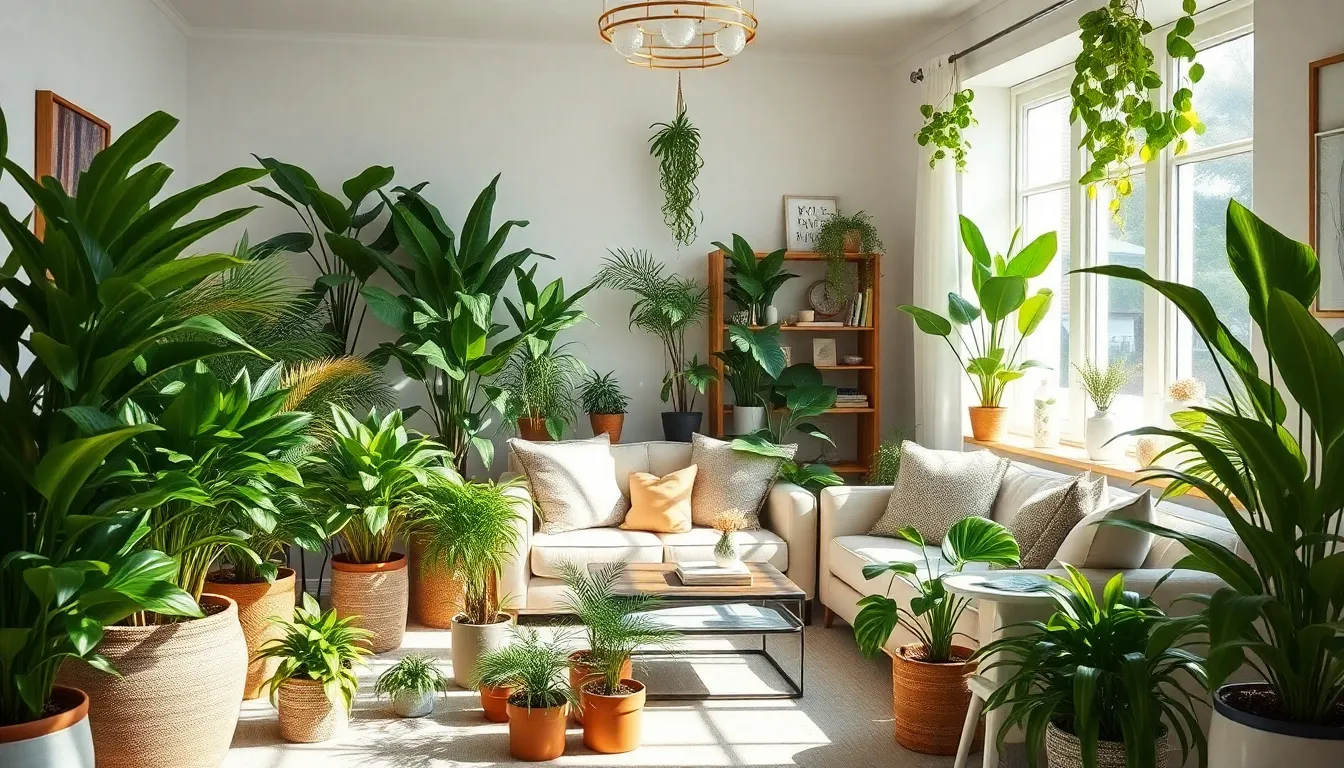
We’ve carefully selected and arranged our living room plants to create stunning displays, but keeping them healthy requires consistent care. Regular maintenance ensures our green companions continue improving our space with vibrant foliage and lasting beauty.
Establishing a Watering Schedule
Check soil moisture levels before watering by inserting your finger about an inch deep into the soil. Plants need water when the top inch feels dry to the touch, preventing both overwatering and dehydration issues that can damage root systems.
Create exact watering routines based on each plant’s individual needs rather than using a one-size-fits-all approach. Spider plants typically require weekly watering sessions, while succulents need irrigation only every two to three weeks depending on humidity levels.
Select pots with proper drainage holes to prevent water accumulation that leads to root rot in our living room plants. Standing water creates anaerobic conditions that kill healthy root systems and compromise plant health over time.
Adjust watering frequency seasonally since plants require less water during winter months when growth naturally slows down. Reduce watering schedules by approximately 50% during dormant periods to match decreased metabolic activity.
Monitoring for Pests and Disease
Inspect plants weekly for early signs of pest infestations such as aphids, spider mites, or scale insects that can quickly spread throughout our living room plant collection. Early detection allows for immediate treatment before problems become severe.
Wash outdoor plants thoroughly before bringing them inside for seasonal protection, removing potential pest hitchhikers that could infest our indoor plant displays. Use gentle soap answers and rinse completely to eliminate hidden insects and eggs.
Prune damaged leaves immediately when you notice signs of disease or pest damage to prevent spread to healthy plant tissue. Remove infected foliage using clean, sharp scissors sterilized between cuts to avoid cross contamination.
Maintain good air circulation around plant groupings to reduce humidity levels that encourage fungal growth and pest reproduction. Position plants with adequate spacing and avoid overcrowding arrangements that trap moisture.
Seasonal Care Adjustments
Reduce winter watering significantly as our living room plants enter dormant periods with slower growth rates and decreased water uptake. Most houseplants need 50-75% less water during cold months compared to active growing seasons.
Protect plants from cold windowsills by placing insulating materials like cardboard between containers and glass surfaces during winter months. Direct contact with cold glass can shock root systems and damage sensitive foliage.
Avoid fertilizing during winter since plants aren’t actively growing and cannot properly use added nutrients until spring growth resumes. Resume feeding schedules when new growth appears in early spring.
Repot pot bound plants in spring when root systems have outgrown their containers and active growth begins again. Fresh potting soil provides renewed nutrients and proper drainage for healthy development.
Increase watering and fertilizing during spring and summer growing seasons when plants require additional resources for new leaf production and overall expansion. Monitor soil moisture more frequently as evaporation rates increase with warmer temperatures.
Conclusion
Living room plants offer us endless possibilities to transform our spaces into vibrant sanctuaries that reflect our personal style. We’ve explored how the right combination of plant selection lighting considerations and thoughtful placement can create stunning displays that breathe life into any room.
Remember that successful plant decor isn’t just about aesthetics – it’s about creating a sustainable network in our homes. When we choose plants that match our lighting conditions maintain proper care routines and integrate them thoughtfully with our existing decor we’re investing in long-term beauty and well-being.
Start with one or two plants that speak to you and gradually build your indoor garden as you gain confidence. Your living room will thank you for the natural elegance and fresh energy that only plants can provide.
Frequently Asked Questions
What are the best plants for low-light living rooms?
Snake plants, ZZ plants, pothos vines, and Chinese evergreens are excellent choices for dim living rooms. These plants thrive in low-light conditions and require minimal maintenance, making them perfect for spaces with limited natural light or north-facing windows.
How do I choose plants for bright, sunny living rooms?
For sunny spots, consider fiddle leaf figs, rubber trees, bird of paradise plants, and monstera deliciosa. These plants love bright light and create dramatic focal points with their large, striking foliage that can handle direct sunlight.
What plants work well in medium-light conditions?
Peace lilies, dracaena varieties, spider plants, and philodendrons are ideal for medium-light areas. These versatile plants adapt well to various lighting conditions and offer beautiful foliage that enhances any living room’s aesthetic appeal.
How should I arrange plants for maximum visual impact?
Use odd-numbered groupings like three or five plants with varying heights and textures. Place tall floor plants as statement pieces, add tabletop plants for surface styling, and incorporate hanging plants to draw the eye upward and utilize ceiling space.
What type of planters should I choose for my living room plants?
Select planters that complement your decor style: modern minimalist containers with clean lines for contemporary spaces, rustic terracotta or wood planters for cozy atmospheres, or colorful statement pots to add vibrant accents to neutral rooms.
How often should I water my living room plants?
Check soil moisture before watering, as each plant has different needs. Most houseplants need watering when the top inch of soil feels dry. Adjust frequency seasonally, watering less in winter when plant growth slows down.
Can plants be used as natural room dividers?
Yes, tall plants like Umbrella Plants and Areca Palms work excellent as natural room dividers. They create lush screens between areas while maintaining an open feel and can define different zones within your living space.
How do I prevent common plant problems like root rot?
Ensure proper drainage in all planters and avoid overwatering. Check soil moisture regularly, inspect plants for pests monthly, and provide adequate airflow around your plants. Use well-draining potting soil and pots with drainage holes.
What’s the best way to integrate plants with existing decor?
Coordinate plants with artwork, use wall shelves to layer plants with decorative objects, and match throw pillows or textiles to reinforce nature themes. Position plants near architectural features like windows or fireplaces to enhance these elements.
When should I repot my living room plants?
Repot plants in spring when they become root-bound, typically every 1-2 years. Signs include roots growing through drainage holes, water running straight through the pot, or stunted growth despite proper care.

